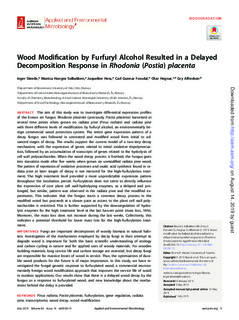| dc.contributor.author | Skrede, Inger | |
| dc.contributor.author | Hess, Jaqueline | |
| dc.contributor.author | Solbakken, Monica Hongrø | |
| dc.contributor.author | Fossdal, Carl Gunnar | |
| dc.contributor.author | Hegnar, Olav Aaseth | |
| dc.contributor.author | Alfredsen, Gry | |
| dc.date.accessioned | 2019-10-08T08:46:48Z | |
| dc.date.available | 2019-10-08T08:46:48Z | |
| dc.date.created | 2019-08-14T12:53:56Z | |
| dc.date.issued | 2019 | |
| dc.identifier.citation | Applied and Environmental Microbiology. 2019, 85(14). | nb_NO |
| dc.identifier.issn | 0099-2240 | |
| dc.identifier.uri | http://hdl.handle.net/11250/2620781 | |
| dc.description.abstract | The aim of this study was to investigate differential expression profiles of the brown rot fungus Rhodonia placenta (previously Postia placenta) harvested at several time points when grown on radiata pine (Pinus radiata) and radiata pine with three different levels of modification by furfuryl alcohol, an environmentally benign commercial wood protection system. The entire gene expression pattern of a decay fungus was followed in untreated and modified wood from initial to advanced stages of decay. The results support the current model of a two-step decay mechanism, with the expression of genes related to initial oxidative depolymerization, followed by an accumulation of transcripts of genes related to the hydrolysis of cell wall polysaccharides. When the wood decay process is finished, the fungus goes into starvation mode after five weeks when grown on unmodified radiata pine wood. The pattern of repression of oxidative processes and oxalic acid synthesis found in radiata pine at later stages of decay is not mirrored for the high-furfurylation treatment. The high treatment level provided a more unpredictable expression pattern throughout the incubation period. Furfurylation does not seem to directly influence the expression of core plant cell wall-hydrolyzing enzymes, as a delayed and prolonged, but similar, pattern was observed in the radiata pine and the modified experiments. This indicates that the fungus starts a common decay process in the modified wood but proceeds at a slower pace as access to the plant cell wall polysaccharides is restricted. This is further supported by the downregulation of hydrolytic enzymes for the high treatment level at the last harvest point (mass loss, 14%). Moreover, the mass loss does not increase during the last weeks. Collectively, this indicates a potential threshold for lower mass loss for the high-furfurylation treatment. | nb_NO |
| dc.language.iso | eng | nb_NO |
| dc.rights | Attribution-NonCommercial-NoDerivatives 4.0 Internasjonal | * |
| dc.rights.uri | http://creativecommons.org/licenses/by-nc-nd/4.0/deed.no | * |
| dc.title | Wood modification by furfuryl alcohol caused delayed decomposition response in Rhodonia (Postia) placenta | nb_NO |
| dc.type | Journal article | nb_NO |
| dc.type | Peer reviewed | nb_NO |
| dc.description.version | publishedVersion | nb_NO |
| dc.source.pagenumber | 21 | nb_NO |
| dc.source.journal | Applied and Environmental Microbiology | nb_NO |
| dc.identifier.doi | 10.1128/AEM.00338-19 | |
| dc.identifier.cristin | 1715880 | |
| cristin.unitcode | 192,12,0,0 | |
| cristin.unitname | Kjemi, bioteknologi og matvitenskap | |
| cristin.ispublished | true | |
| cristin.fulltext | original | |
| cristin.qualitycode | 2 | |

